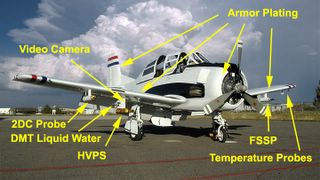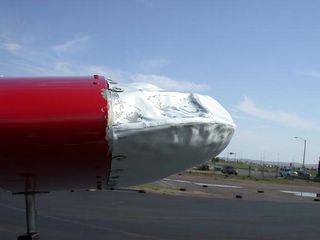The ariplane was N10WX, a highly modified T-28 Trojan (WX is a common abbreviation for 'weather'). In the early 1960's the South Dakota School of Mines and Technology's Institute of Atmospheric Sciences began operating this bird as a scientific research platform, and until early 2004 flew it hundreds of times into storms that other pilots would take every possible precaution to avoid. Why choose a 1950's trainer in the 1960's, and operate it this long? Several reasons. First, it had a piston-driven prop rather than a turbofan - jet engines don't do so well in heavy hail, stalling and being unable to re-start. Second, it had a airframe strength/engine power combination that could support two heavy items: armor plating and a thick coat of ice. Third, that airframe was designed to withstand a lot of punishment (think keeping student pilots safe...). And fourth, there were a lot of them available for a good price (over 2200 were built - the other choice was the Douglas Dauntless, but purchase cost and maintenance ruled it out).
Here's a picture of the T-28, with some of the features pointed out:

Armored T-28

Of course, there are many more instruments and hard points for mounting them than shown here. The 700 lbs of armor plating is on all the tops and leading edges of the wings and the rudder and the radial engine cowling, and of course the canopy is also armored - the original plexiglass 'bubble' would never survive!
Here's the kind of damage the hail does - this is a shot of the wing-tip, and you can clearly see the difference that the armor plating makes - the original aluminium wing covering is severely battered, while the armor does not show any damage.

T-28 wingtip

There are several other areas that are heavily armored - the air intakes for the carburetor and for the oil cooler.
Of course, anything that stuck out was either going to get hammered or struck by lightning. What would usually be somewhat delicate instruments on other aircraft had to be modified (I wonder what the Pitot looks like on this thing?). Here's a shot of a detector with a somewhat crumpled dome...

instrument

My first thought on seeing these pictures was that it must have been incredibly LOUD in the cockpit. Not only were you riding a 1425 hp Wright Cyclone at several hundred knots, but the noise from the hail must have beed absolutely deafening, mixed in with the occasional lightning strike (which resulted in pieces melting off the trailing edges of the prop and rudder!).
Now that it has been retired, the School of Mines is in contact with the Smithsonian and others to see if anyone is interested in exhibiting N10WX. And of course, the scientific community is looking for another platform that can take this kind of punishment and keep the pilot safe. The candidates so far: an Air Force A-10 Thunderbolt "Warthog" (but chances are not good for an A-10 being released, given the current operations needs for both active ariframes and spares...); or a Coast Guard HU-25 Falcon. Both of these of course are turbofans - it will be interesting to see how the replacement holds up over 50 years of service - if they even make it that long.
The long-time pilot for the T-28, Tom Warner, has a nice homepage for the airplane here (as well as having some great WX photos that deserve a look!).
1 comment:
Something that irritates me is this museum piece is sitting in pieces in a non-discript T-hangar on the NW side of Rockford Airport, Rockford IL. Two companies (Courtesy aircraft and Heritage aero) have bought it in conjunction to part it out and make a profit out of it. Unless saved this aircraft may never see it's rightful home of a museum but will instead be made into pop cans.
Post a Comment